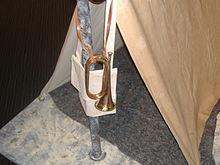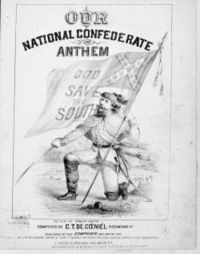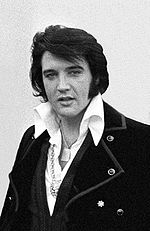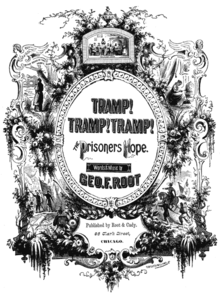- Music of the American Civil War
-
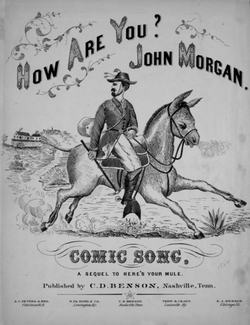 Typical cover of sheet music, with songs depicting the individuals of the era, such as John Hunt Morgan
Typical cover of sheet music, with songs depicting the individuals of the era, such as John Hunt Morgan
During the American Civil War, music played a prominent role on both sides of the conflict: Union and Confederate. On the American Civil War battlefield, different instruments including bugles, drums, and fifes were played to issue marching orders or sometimes simply to boost the morale of one's fellow soldiers. Singing was also employed as a recreational activity, but as a release from the inevitable tensions that come with fighting in a war, particularly a war in which the issue of freedom of a race is to be decided. In camp, music was a diversion away from the bloodshed, helping the soldiers deal with homesickness and boredom. Soldiers of both sides often engaged in recreation with musical instruments, and when the opposing armies were near each other, sometimes the bands from both sides of the conflict played against each other on the night before a battle.
Each side had its particular favorite tunes, while some music was enjoyed by Northerners and Southerners alike, as exemplified by United States President Abraham Lincoln's love of Dixie, the unofficial anthem of the Confederacy. To this day, many of the songs are sung when a patriotic piece is required. The war's music also inspired music artists such as Lynyrd Skynyrd and Elvis Presley.
Contents
Regulations
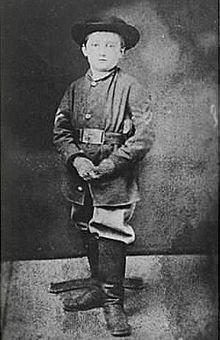 John Clem, a twelve-year-old Union drummer boy
John Clem, a twelve-year-old Union drummer boy
In May 1861 the United States War Department officially approved that every regiment of infantry and artillery could have a brass band with 24 members, while a cavalry regiment could have one of sixteen members. The Confederate army would also have brass bands. This was followed by a Union army regulation of July 1861 requiring every infantry, artillery, or cavalry company to have two musicians and for there to be a twenty-four man band for every regiment.[1] The July 1861 requirement was ignored as the war dragged on, as riflemen were more needed than musicians. In July 1862 the brass bands of the Union were disassembled by the adjutant general, although the soldiers that comprised them were sometimes reenlisted and assigned to musician roles. A survey in October 1861 found that 75% of Union regiments had a band.[2] By December 1861 the Union army had 28,000 musicians in 618 bands; a ratio of one soldier out of 41 who served the army was a musician, and the Confederate army was believed to have a similar ratio.[3]
Musicians were often given special privileges. Union general Phillip Sheridan gave his cavalry bands the best horses and special uniforms, believing "Music has done its share, and more than its share, in winning this war".[4]
Musicians on the battlefield were drummers and buglers, with an occasional fifer. Buglers had to learn forty-nine separate calls just for infantry, with more needed for cavalry. These ranged from battle commands to calls for meal time.[5] Some of these required musicians were drummer boys not even in their teens, which allowed an adult man to instead be a foot soldier. The most notable of these under aged musicians was John Clem, also known as "Johnny Shiloh". Union drummers wore white straps to support their drums. The drum and band majors wore baldrics to indicate their status; after the war, this style would be emulated in civilian bands. Drummers would march to the right of a marching column. Similar to buglers, drummers had to learn 39 different beats: fourteen for general use, and 24 for marching cadence. However, buglers were given greater importance than drummers.[6]
On the battlefield
 Band of the 26th North Carolina Regiment, C.S.A.
Band of the 26th North Carolina Regiment, C.S.A.
Whole songs were sometimes played during battles. The survivors of the disastrous Pickett's Charge returned under the tune Nearer My God to Thee.[7] At the Battle of Five Forks, Union musicians under orders from Sheridan played Nelly Bly while being shot at on the front lines.[8] Samuel P. Heintzelman, the commander of the III Corps, saw many of his musicians standing at the back lines at the Battle of Williamsburg, and ordered them to play anything.[9] Their music rallied the Union forces, forcing the Confederate to withdraw. It was said that music was the equivalent of "a thousand men" on one's side. Robert E. Lee himself said, "I don't think we could have an army without music."[10]
Often, musicians were ordered to leave the battlefront and assist the surgeons. One notable time was the 20th Maine's musicians at Little Round Top. As the rest of the regiment were driving back wave after wave of Confederates, the musicians of the regiment were not just performing amputations, but doing it in a very quick manner.[11][12]
In camp
 Locations of the different sides the night of the band duel before the Battle of Stones River.
Locations of the different sides the night of the band duel before the Battle of Stones River.
Many soldiers brought musical instruments from home to pass the time at camp. Banjos, fiddles, and guitars were particularly popular. Aside from drums, the instruments Confederates played were either acquired before the war, or imported, due to the lack of brass and the industry to make such instruments.[13][14]
Musical duels between the two sides were common, as they heard each other as the music traveled across the countryside. The night before the Battle of Stones River, bands from both sides dueled with separate songs, until both sides started playing Home! Sweet Home!, at which time soldiers on both sides started singing together as one.[15] A similar situation occurred in Fredericksburg, Virginia in the winter of 1862–3. On a cold afternoon a Union band started playing Northern patriotic tunes; a Southern band responded by playing Southern patriotic tunes. This back and forth continued into the night, until at the end both sides played Home! Sweet Home! simultaneously, to the cheers of both sides' forces.[16] In a third instance, in the spring of 1863, the opposing armies were on the opposite sides of the Rappahannock River in Virginia, when the different sides played their patriotic tunes, and at taps one side played Home! Sweet Home!, and the other joined in, creating "cheers" from both sides that echoed throughout the hilly countryside.[17]
Both sides sang Maryland, My Maryland, although the lyrics were slightly different. Another popular song for both was Lorena. When Johnny Comes Marching Home was written in 1863 by Patrick Gilmore, an immigrant from Ireland, and was also enjoyed by both sides.[18][19]
Homefront
 George F. Root
George F. Root
The first song written for the war, The First Gun is Fired, was first published and distributed three days after the Battle of Fort Sumter. George F. Root, who wrote it, is said to have produced the most songs of anyone about the war, over thirty in total.[20] Lincoln once wrote a letter to Root, saying, "You have done more than a hundred generals and a thousand orators".[21]
The southern states had long lagged behind northern states in producing common literature. With the advent of war, Southern publishers were in demand. These publishers, based largely in five cities (Charleston, South Carolina; Macon, Georgia; Mobile, Alabama; Nashville, Tennessee' and New Orleans, Louisiana), produced five times more printed music than they did literature.[22]
In the Confederate States of America, God Save the South was the official national anthem. However, Dixie was the most popular.[23] United States President Abraham Lincoln said he loved Dixie and wanted to hear it played, saying "as we had captured the rebel army, we had also captured the rebel tune".[24] At an April 9, 1865 rally, the band director was surprised when Lincoln requested that the band play Dixie. Lincoln said, "That tune is now Federal property...good to show the rebels that, with us in power, they will be free to hear it again".[25] The other prominent tune was The Bonnie Blue Flag, and like Dixie was written in 1861, unlike Union popular tunes which were written throughout the war.[26]
The United States did not have a national anthem at this time (Star Spangled Banner would not be recognized as such until the twentieth century). Union soldiers frequently sang the Battle Cry of Freedom, and the Battle Hymn of the Republic was considered the north's most popular song.[27]
Different versions
Although certain songs were identified with one particular side of the war, sometimes the other would adapt the song for their use. A Southern revision of the Star Spangled Banner was used, entitled "The Southern Cross". In an example of the different lyrics, where the Banner had "O say does that Star Spangled Banner yet wave", the Cross had "'Tis the Cross of the South, which shall ever remain".[28] Another Confederate version of the Star Spangled Banner, called The Flag of Secession, replaced the same verse with "and the flag of secession in triumph doth wave".[29] Even a song from the American Revolutionary War was adapted, as the tune Yankee Doodle was changed to "Dixie Doodle", and started with "Dixie whipped old Yankee Doodle early in the morning".[30] The Union's Battle Cry of Freedom was also altered, with the original lines of "The Union forever! Hurrah, boys, hurrah! Down with the traitor, up with the star" being changed to "Our Dixie forever! She's never at a loss! Down with the eagle and up with the cross!"[31]
The Union also adapted Southern Songs. In a Union variation of Dixie, instead of the line "I wish I was in the land of cotton, old times there are not forgotten, Look away, look away, look away, Dixie Land", it was changed to "Away down South in the land of traitors, Rattlesnakes and alligators, Right away, come away, right away, come away".[32]
Legacy
The music derived from this war was of greater quantity and variety than from any other war involving America.[33] Songs came from a variety of sources. Battle Hymn of the Republic borrowed its tune from a song sung at Methodist revivals. Dixie was a minstrel song that Daniel Emmett adapted from two Ohio black singers named Snowden.[34] American soldiers would continue to sing Battle Hymn of the Republic in the Spanish-American War, World War I, and World War II.[35]
The Southern rock style of music has often used the Confederate Battle Flag as a symbol of the musical style. Sweet Home Alabama by Lynyrd Skynyrd was described as a "vivid example of a lingering Confederate mythology in Southern culture".[36]
A ballad from the war, Aura Lee, would become the basis of the song Love Me Tender by Elvis Presley. Presley also sang An American Trilogy, which was described as "smoothing" out All My Trials, the Battle Hymn of the Republic, and Dixie of its divisions, although Dixie still dominated the piece.[37]
Songs published per year
w. = Words by
m. = Music by1861
- The First Gun is Fired, w.m. George F. Root
- The Bonnie Blue Flag, w. Mrs Annie Chamber-Ketchum m. Harry MacCarthy
- I'm Going Home to Dixie, w. Dan Emmett a. C. S. Grafully
- John Brown's Body, w. anonymous m. William Steffe (came to be the unofficial theme song of black soldiers.)
- Maryland, My Maryland, w. James Ryder Randall m. Walter de Mapers (Music "Mini est Propositum" 12th century)
- The Vacant Chair, w. Henry S. Washburne m. George Frederick Root
1862
- Here's Your Mule, - C. D. Benson
- Battle Cry of Freedom, - George F. Root
1863
- All Quiet Along the Potomac Tonight, w.m. John Hill Hewitt
- Just Before the Battle, Mother, by George F. Root
- Mother Would Comfort Me, w.m. Charles C. Sawyer
- Tenting on the Old Camp Ground, w.m. Walter Kittredge
- Weeping Sad And Lonely, w. Charles Carroll Sawyer m. Henry Tucker
- When Johnny Comes Marching Home Again, by Louis Lambert & Patrick Gilmore
- You Are Going to the Wars, Willie Boy!, w.m. John Hill Hewitt
- The Young Volunteer, w.m. John Hill Hewitt
1864
- Tramp! Tramp! Tramp! (The Boys Are Marching), w.m. George F. Root
1865
- Jeff in Pettycoats, w.m. Henry Tucker
- Marching Through Georgia, w.m. Henry Clay Work
- Good Bye, Old Glory, w. L. J. Bates, m. George Frederick Root
Media
See also
- Music history of the United States during the Civil War era - a view of music of the time period outside of the military
- Abraham Lincoln and Civil War songs
- American Song Sheets - Duke University Libraries Digital Collections - Includes images and text of over 1,500 Civil War song sheets
- Category:Songs of the American Civil War
Notes
- ^ Lanning p.243
- ^ Lanning p.243
- ^ Lanning p.243, Vaughan pp.194,195
- ^ Lanning pp.244
- ^ Amedeo p.127, Miller p.92
- ^ Lanning p.243, Miller p.96
- ^ Lanning p.244
- ^ Lanning p.244
- ^ Lanning p.244
- ^ Lanning pp.243,244
- ^ Music of the Civil War National Park Service.gov
- ^ Turner p.151, Vaughan p.195
- ^ Heidler p.1173, Miller p.190
- ^ Music of the Civil War National Park Service.gov
- ^ Amedeo p.257, Vaughan p.194
- ^ Music of the Civil War National Park Service.gov
- ^ Branham p.131
- ^ Amedeo p.77, 127
- ^ Lanning p.245
- ^ Kelley p.30, Silber p.7
- ^ Branham p.132
- ^ Harwell pp.3,4
- ^ Lanning p.245
- ^ Branham p.130
- ^ Donald p.580
- ^ Silber p.8
- ^ Lanning pp.245
- ^ Harwell pp.64,65
- ^ Branham p.130
- ^ Harwell pp.67
- ^ Silber p.10
- ^ Van Deburg p.109
- ^ Silber p.4
- ^ Heidler pp.191,607
- ^ Ravitch p.257
- ^ Kaufman pp.x,81
- ^ Amedeo p.111, Kaufman p.83
References
- Amedeo, Michael (2007). Civil War: Untold stories of the Blue and the Gray. West Side Publications. ISBN 1412714184.
- Branham, Robert J. (2002). Sweet Freedom's Song: "My Country 'tis of Thee" and Democracy in America. Oxford University Press US. ISBN 0195137418.
- Donald, David Herbert (1995). Lincoln. Simon and Schuster. ISBN 068482535X.
- Harwell, Richard B. (1950). Confederate Music. Chapel Hill, North Carolina: University of North Carolina Press.
- Heidler, David (2002). Encyclopedia of the American Civil War. W. W. Norton & Company. ISBN 039304758X.
- Kaufman, Will (2006). The Civil War in American Culture. Edinburgh University Press. ISBN 0748619356.
- Kelley, Bruce (2004). "An Overview of Music of the Civil War Era" Bugle Resounding. University of Missouri Press. ISBN 0813123755.
- Knouse, Dr. Nola Reed "Music from the Band Books of the 26th Infantry Regiment, NC Troops, C.S.A.". Liner notes essay. New World Records.
- Lanning, Michael (2007). The Civil War 100. Sourcebooks, Inc.. ISBN 140221040x.
- Miller, David (2001). Uniforms, Weapons, and Equipment of the Civil War. London: Salamander Books Ltd.. ISBN 1840652578.
- Ravitch, Diane (2000). The American Reader: Words that Moved a Nation. HarperCollins. ISBN 0062737333.
- Silber, Irwin (1995). Songs of the Civil War. Courier Dover Publications. ISBN 0486284387.
- Turner, Thomas Reed (2007). 101 Things You Didn't Know about the Civil War. Adams Media. ISBN 1598693204.
- Van Deburg, William L. (1984). Slavery & Race in American Popular Culture: In American Popular Culture. University of Wisconsin Press. ISBN 0299096343.
- Vaughan, Donald (2000). The Everything Civil War Book. Holbrook, Massachusetts: Adams Media Corporation. ISBN 1580623662.
- Southern, Eileen (1997). The Music of Black Americans. New York, New York: W.W. Nortan & Company, Inc. pp. 206–212. ISBN 0-393-97141-4.
American Civil War (outline) Origins - Combatants
- Theaters
- Campaigns
- Battles
- States
CombatantsTheatersMajor battles- Fort Sumter
- 1st Bull Run
- Wilson's Creek
- Fort Donelson
- Pea Ridge
- Hampton Roads
- Shiloh
- New Orleans
- Corinth
- Seven Pines
- Seven Days
- 2nd Bull Run
- Antietam
- Perryville
- Fredericksburg
- Stones River
- Chancellorsville
- Gettysburg
- Vicksburg
- Chickamauga
- Chattanooga
- Wilderness
- Spotsylvania
- Cold Harbor
- Atlanta
- Mobile Bay
- Franklin
- Nashville
- Five Forks
Involvement
by state or territoryLeaders ConfederateMilitaryCivilianUnionMilitaryCivilianAftermath - Alabama Claims
- Carpetbaggers
- Freedman's Bank
- Freedmen's Bureau
- Jim Crow laws
- Redeemers
- Southern Claims Commission
Cemeteries- Confederate memorials and cemeteries
- National cemeteries
- U.S. memorials and cemeteries
VeternsOther topics- Related topics
- Categories
Related topicsMilitaryPoliticalOther topicsCategories- American Civil War
- People
- Battles
- Union Army generals
- Union armies
- Union Army corps
- Confederate States of America (CSA)
- Confederate Army generals
- Confederate armies
- Spies
- National Battlefields
- Veterans' organizations
- Medicine
- Museums
- Forts
- Old soldiers' homes
- Prisons
- Reconstruction
- U.S. memorials and cemeteries
- Confederate memorials and cemeteries
American Civil War at sister projects  American Civil War portal
American Civil War portal Military History: American Civil War
Military History: American Civil War Special Project: Brothers at War
Special Project: Brothers at War
Categories:- Social history of the American Civil War
- Songs of the American Civil War
Wikimedia Foundation. 2010.

